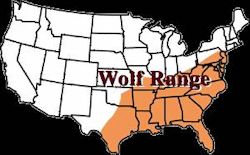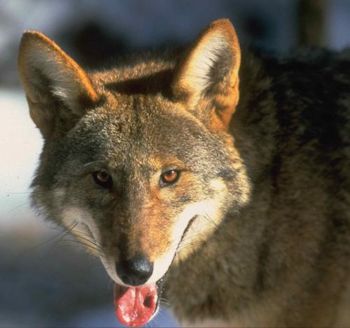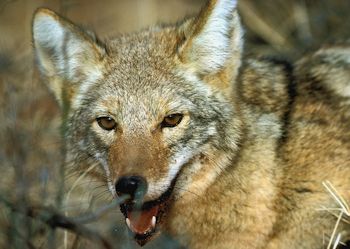MANTEO — Twenty-five years after the first captive-bred red wolves were released into the swamps and pine forest of Alligator River National Wildlife Refuge, the success of the Red Wolf Recovery Program is intertwined in an uneasy relationship with the wolf’s close cousin, the coyote.
The wolves were declared extinct in 1980, but now 100 to 120 of them roam freely, and exclusively, in a five-county range in northeastern North Carolina.
Supporter Spotlight
So far, biologists with the U.S. Fish and Wildlife Service’s program have effectively managed to keep prolific coyotes from interbreeding with red wolves, a behavior that had become a major threat to the wolves’ recovery.
 The red wolves once ranged throughout the Southeast. |
The management technique combines human interference and natural territorial response. A coyote would be captured, sterilized and returned to the same place in the wild. It would then instinctively hold the territory, blocking interloping —and fertile — coyotes from entering. Eventually, a larger red wolf will move in and take over.
“We’ve had great success with that,” said David Rabon, coordinator of the Red Wolf Recovery Program. “In all cases, wolves will kill or displace the coyote. There have been no cases where the coyotes will kill or displace the wolf.”
But unnatural causes of mortality — gunshots, vehicle strikes — are more difficult to solve.
A recent state decision to permit night-time coyote hunting has coincided with the shooting deaths between September and November of four radio-collared red wolves, renewing issues with co-existing coyote and wolf populations.
Supporter Spotlight
In August 2012, the N.C. Wildlife Resources Commission implemented a temporary rule that allows hunters to use a light when shooting coyotes on private lands at night. The problem is that the animals, with their big ears and similar body shape, look a lot like red wolves, which are protected under the federal Endangered Species Act. After a court challenge by conservation groups, a judge issued a temporary injunction in late November on the practice within the red wolf recovery area — Dare, Tyrrell, Hyde, Washington and Beaufort counties.
The investigation into the shootings is continuing.
David Cobb, chief of the commission’s Division of Wildlife Management, said that coyotes can be found in every one of the state’s 100 counties, and have been known to stray into a city or two. Although they’re rarely aggressive to humans, they frequently prey on livestock and even pets.
“The commission made the decision that they need to move forward to provide landowners with options to manage their properties,” Cobb said.
Cobb said that a study is underway to determine the coyote population in the state, but it appears to be growing. Hunters can shoot as many coyotes as they want every day of the year, as long as it’s on private land and they have permission of the landowner. On Sunday, only archery equipment can be used.
 |
 Red wolves, top, and coyotes look a lot a like, especially at night. A new state policy that allows nighttime hunting of coyotes had conservation groups worried that wolves would be shot by mistake. A judge agreed and stopped the hunting program in the five-county wolf recovery area. |
Last year, about 36,000 coyotes were killed in the state by 32,388 registered hunters, according to a mail survey of hunters, Cobb said. Responding to a new question in the 2011 survey, 12 percent of the hunters said they shot the coyote incidentally while hunting other animals.
The hunter is responsible for determining whether it is a red wolf or a coyote before deciding to shoot, Cobb said. There are stiff penalties for shooting an endangered species.
To a large extent, hunting led to the decimation of the red wolves in the 1960s, when predator controls coupled with habitat loss essentially wiped out the species in the southeastern U.S. Biologists found a small population surviving along the Gulf Coast, and eventually 14 captured wolves became a fruitful breeding colony.
Red wolf pups were bred successfully in captivity for 10 years, and it was decided to begin an experimental restoration program in the Alligator River refuge. Four adult pairs were released in September 1987; by 1992, there were at least 30 wolves in the wild. Theit range has since expanded to 1.7 million acres.
Today, according to the most recent 2012 program report, there are 71 known wolves — many with tracking collars — in the recovery area, including 15 wolf packs and eight mixed packs of wolves and coyotes. There were also 45 sterile coyotes being monitored in the recovery area.
Nine confirmed red wolf litters — a total of 40 pups — were born in 2012, and two captive-born pups were placed with a foster mother in the refuge.
Also, about 200 captive wolves are part of the breeding program at other U.S. locations.
In one of the program’s most encouraging accomplishments, three captive-born wolf pups fostered in the wild, now mature, had their own pups in the wild this year.
“If you think about what is the ultimate success,” Rabon said. “One is they survive the fostering — the percentage is 90 percent, which is incredibly high. But the true success is not only surviving, but becoming a reproducing adult.”
Today, the recovery program has eight full-time staff, and enough money to keep it moving forward, Rabon said. A new facility in Columbia run by the Red Wolf Coalition, a nonprofit that works closely with the recovery program, is focused on education and public outreach and has a couple of captive-born wolves onsite that can be viewed by appointment. The other facility in the refuge mostly houses captive wolves for management purposes and is not open to the public.
Alligator River’s red wolf recovery program has been lauded as a model for other wolf recovery programs in the country. But Rabon concedes that the population has been stagnant for a number of years — the goal has been to have about 220 wolves in the wild — and the program is being reevaluated.
The biggest challenge, he said, is addressing losses in the population that create holes, whether it’s a coyote or a wolf. Whatever animal moves back in, especially if it’s a fertile coyote, can threaten the management success in preventing hybridization, among other challenges.
“It’s the loss that creates that hole that has the potential to create a domino effect,” he said. “It creates a disruption. It never allows things to reach an equilibrium.”
It’s not that mortalities are not expected in management, Rabon said, it’s the convergence of unnatural and natural factors all at one time that can compound the destabilizing effect.
In evaluating what is contributing to the management issues and examining ways to mitigate or abate the problems, he said, the conclusion may be that change is here to stay.
“If it is a new normal,” Rabon said, “then we’re trying to develop new ideas for that.”
Meanwhile, the program is investigating expansion to an additional recovery site in the southeastern U.S, one with a fair amount of open wilderness, a suitable food supply and a willing and tolerant human population.
“I think for the most part, people have seen 25 years of a restoration program,” Rabon said. “The wolves have not taken livestock or threatened their homes or property. The majority of people don’t see them as a threat they once may have seen them as.”








